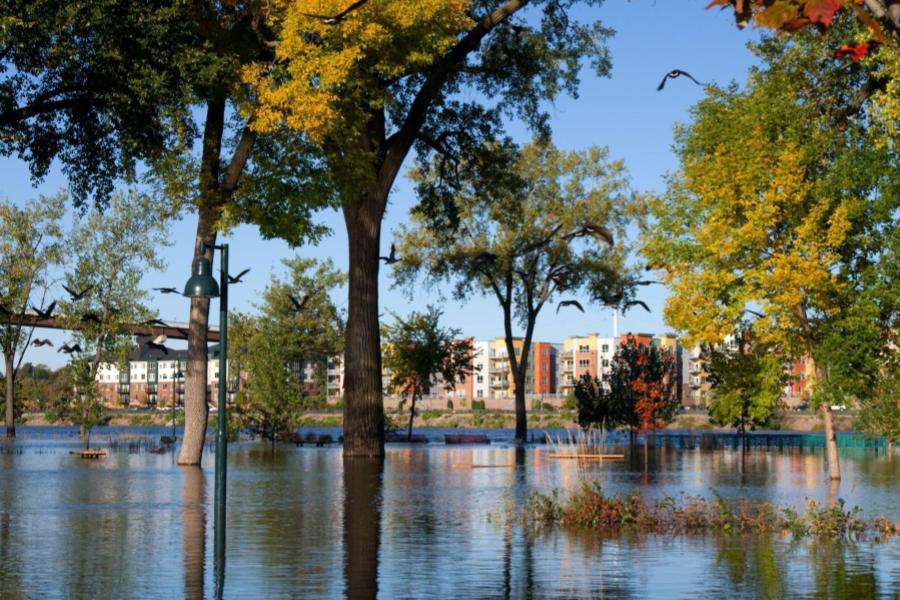
Across the United States, extreme weather events are leaving destroyed property and displaced people in their wake. New data from the Census Bureau estimates that 2.5 million Americans were displaced because of weather-related disasters last year, including approximately 9,000 Minnesotans.
Richard Graves, an associate professor in the University of Minnesota's College of Design and director for the Center for Sustainable Building Research, answers questions about how Minnesota can better prepare our buildings and infrastructure for the future.
Q: What kinds of extreme weather events in Minnesota are likely to impact our infrastructure?
Prof. Graves: As we look at the effects of a changing climate in Minnesota, our state is getting warmer with larger storms in the spring, summer and fall that are increasingly disruptive to infrastructure in Minnesota. These types of storms bring localized flooding with extreme rainfall, high temperatures and high humidity which damage buildings, roads, wastewater systems and other infrastructure.
Q: Are certain types of buildings more at risk?
Prof. Graves: As high temperatures and high humidity become more of a challenge, buildings with less insulation and no humidity control systems are going to be harder to operate.
Q: What are some examples of creating sustainable infrastructure?
Prof. Graves: At the U of M, we are looking at improving the insulation and mechanical systems of the built environment in Minnesota, integrating solar storage and better site design to enable buildings to thrive in a changing climate.
We have been working with a number of communities on developing a Resilience Hub — a physical space familiar to its community, like a community recreation center, that can serve as a central resource to support residents. A Hub offers a trusted location to centralize preparations before a natural disaster, coordinate and distribute resources, mount a response in the aftereffects of a natural disaster and more.
Q: How can communities learn more about Resilience Hubs?
Prof. Graves: The first thing to consider is that Hubs are meant to shift power to community members. With that in mind, Hubs should be co-developed by residents or community-based organizations. A successful Hub will consider the history of its community and its relationship with public safety or government institutions. The establishment of a Hub will also require a core group of committed people, which includes community members.
Communities interested in Resilience Hubs should reach out to me at the Center for Sustainable Building Research for examples of work in Minnesota with communities and in our architecture studio in the School of Architecture’s master’s program. In addition, I would recommend visiting the Urban Sustainability Directors Network's Resilience Hubs website and taking advantage of the resources provided there.
Q: Are there any steps Minnesotans can take to be proactive in their homes and communities?
Prof. Graves: In their homes, Minnesotans should look at improving the insulation and mechanical system to increase their capability to work in extreme heat.
In communities, I would encourage groups to use the resources we have at the Center for Sustainable Building Research and what they can find from their city, county, state or federal governments to do some scenario planning on the potential impacts of a changing climate and ways they can adapt their current infrastructure to be not only sustainable but also resilient to those changes.
Richard Graves is an associate professor in the College of Design and director for the Center for Sustainable Building Research at the University of Minnesota. His research focuses include energy and climate change, equitable designs, sustainable materials and creating regenerative and resilient communities to respond and adapt to stress and change in a dynamic global environment.
About the College of Design
Located in a major design city and in one of the largest research universities in the U.S., the University of Minnesota's College of Design encompasses a full range of design disciplines — including landscape architecture, architecture, retail merchandising, and the design of interiors, graphics, apparel, and other products. Faculty, students, and staff aim to advance the quality of manufactured objects and our natural, built, and social environments through sustainably resilient, socially responsible, civically engaged and human-centered design collaborations. Learn more at design.umn.edu.
About “Talking...with U of M”
“Talking...with U of M” is a resource whereby University of Minnesota faculty answer questions on current and other topics of general interest. Feel free to republish this content. If you would like to schedule an interview with the faculty member or have topics you’d like the University of Minnesota to explore for future “Talking...with U of M,” please contact University Public Relations at [email protected].
- Categories:
- Architecture and Design
- Climate Change





